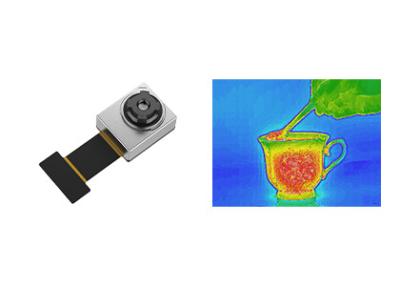



| Price | Negotiable |
| MOQ | 1 Piece |
| Delivery Time | Negotiable |
| Brand | GST |
| Place of Origin | Wuhan, Hubei Province, China |
| Certification | ISO9001:2015; RoHS; Reach |
| Model Number | TIMO120 |
| Payment Terms | L/C, T/T |
| Place of Origin | Wuhan, Hubei Province, China | Spectral Range | 8~14μm |
| NETD | ≤60mK | Size | 8.5x8.5x9.16mm |
| Model Number | TIMO120 | Certification | ISO9001:2015; RoHS; Reach |
| Brand Name | GST | Payment Terms | L/C, T/T |
| Pixel Pitch | 17μm | Price | Negotiable |
| Minimum Order Quantity | 1 Piece | Temperature Range | -20℃~+120℃ (Customizable) |
| Resolution | 120x90 |
120x90 / 17μm Micro Infrared Thermal Camera Core for Smart Home, Intelligent Building
TIMO120 infrared thermal module integrates 120x90 / 17μm wafer level package (WLP) infrared detector and is oriented for applications of optimized size, weight, power, cost (SWaP-C). Its super miniature structure is easy to be integrated into various smart devices, thermal imagers or mobile terminals with strict requirements on cost, size and weight.
Compared with traditional temperature measuring tools, the TIMO120 IR sensor module has greater sensitivity than the common thermopile arrays during the epidemic prevention. Also by using wafer level packaging, TIMO120 thermal sensor camera module is more affordable in the infrared imaging applications that need strict requirements on cost, size and weight.
Thanks to the WLP technology, TIMO series uncooled thermal module is preferred in the emerging markets like consumer electronics. It’s easier for TIMO thermal imaging module to be integrated into more terminal products and shorten secondary development time of customers.
- Minimum size at 8.5x8.5x9.16mm
- Temperature range from -20℃~+120℃
- Easy integration
- Complete SDK development kit
- Low power design as low as 9mW
| Model | TIMO-120 |
| IR Detector Performance | |
| Resolution | 120x90 |
| Pixel Pitch | 17μm |
| Spectral Range | 8~14μm |
| NETD | ≤60mK |
| Lens Type | WLO |
| Focus Mode | Fixed Zoom |
| HFOV | 90°/50° |
| Depth of Field | 10cm to Infinity |
| Frame Rate | 1~30Hz (Customizable) |
| Temperature Measurement | |
| Temperature Range | -20°C ~ +120°C (Customizable) |
| Temperature Accuracy | Customizable (Meet the Requirements of Body or Industrial Thermography) |
| Interface/Control | |
| AVDD | 3.6V±0.05V |
| VSK/VDET | 4.7±0.05V |
| DVDD | 1.8V±0.05V |
| Interface | Digital Interface |
| Power Consumption | 45mW (Typical Mode); 9mW (Low Power Mode) |
| Physical Characteristics | |
| Dimension (mm) | 12x10x5.48 (HFOV=90°); 8.5x8.5x9.16 (HFOV=50°) (The Specifications Shall Prevail) |
| Operation Temperature | -20°C ~ +60°C |
| Storage Temperature | -40°C ~ +85°C |
The TIMO120 thermal camera module is widely used in many areas, such as Thermography, Intelligent Hardware, Smart Building, Smart Home, AIoT etc.


1. What is infrared thermal imaging?
In nature, all objects whose temperature is higher than absolute zero (- 273 ℃) can radiate infrared rays. By using the infrared camera detector to measure the infrared radiation temperature difference between the target itself and the background, you can get different infrared images, which are also called thermal images.
2. How do infrared detectors work?
Infrared radiation that emitted by target enters the sensing range of the thermal detector, then the infrared detector converts the radiation signal of different intensity into the corresponding electrical signal, and then through amplification and video processing, forms the infrared image that can be observed by the naked eyes.
3.
What's
the
advantage
of
uncooled
infrared
detector?
Uncooled
infrared
focal
plane
detector
does
not
need
an
Integrated
Dewar
Cooler
Assembly
(IDCA)
device
and
can
work
at
room
temperature.
It
has
the
advantages
of
fast
start,
low
power
consumption,
small
size,
light
weight,
long
life,
low
cost
and
so
on.
Although
the
sensitivity
of
uncooled
infrared
focal
plane
detector
is
not
as
good
as
that
of
cooled
infrared
detectors,
after
years
of
development,
its
cost
performance
has
been
obviously
better
than
the
cooled
detector,
which
has
a
broader
application
prospect.